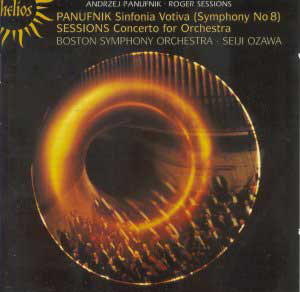This is in part for the taut intellectual tastes and reflexes
of modernists although, quite properly, the appeal of Panufnik's music
is to a wider compass.
The two works share a common fons et origo:
the commemoration of the Bostonians' centennial. They were written in
(comparatively) modern times by composers in their high maturity. Linguistically
the two speak a different tongue. The Sessions piece is in a single
movement playing for a minute over fifteen minutes. In my experience
of the orchestral Sessions he was pretty consistently dodecaphonic but
old age in this case wrung from him a dreamy expressionistic beauty.
Still this is arduous going expressive in a language beloved of the
musical elite of the sixties and seventies. Sessions' First Symphony
was given by the Bostonians in 1927 and his Third in 1957. The composer
clearly harboured great affection for the orchestra.
Panufnik touches off different reactions. He was a
composer of music that typically alternates quiet and loud, slow and
fast, meditative and exuberant. This dichotomy can also be traced in
works such as the Piano Concerto and the symphonies Elegiaca,
Sfere and Mistica. The changes are usually stark rather
than built. His music has it in its fabric to be accessible and quickly
rewarding without being facile. The Votiva is in two movements:
the first a contemplative andante in which the dynamic landscape
migrates between piano and pianissimo. Ideas and orchestration are of
chamber music clarity - quiet, clean, prayerful and sincere touched
by Bartók (a voice I also traced in the music of Viteszlava Kapralova
on a Studio Matous disc). This could easily have been a movement from
a string quartet. Panufnik is an adept of patterning and a step towards
minimalism. The second movement is fast and often loud in the manner
of the Grimes storm. It is nowhere near as belligerent as in
the glorious and unaccountably neglected Elegiaca. Those who
have the Louisville Edition LP can sample this fine work. The abruptness
of the end of the second movement of Votiva (and of the symphony)
is a weak spot.
The Votiva was written without programmatic
intent but with the Black Madonna of Czestochowa in mind as well as
the early eighties rise of the Solidarnosc movement under the leadership
of Lech Walesa.
Technically this disc showed that digital was not the
glassy inferior to analogue claimed by those early days Luddites you
came across far more frequently in the early 80s than you do now. As
an audio artefact this pairing has always stood tall from the time of
its first issue in the vinyl twilight of 1982.
The two composers provide thorough programme notes
with musical technicalities balanced with biographical backdrop.
The Sessions was premiered on 23 October 1981; the
Panufnik on 28 January 1982. The recording sessions pre-dated the concert
premieres in Boston.
Short commons in playing time.
Rob Barnett


